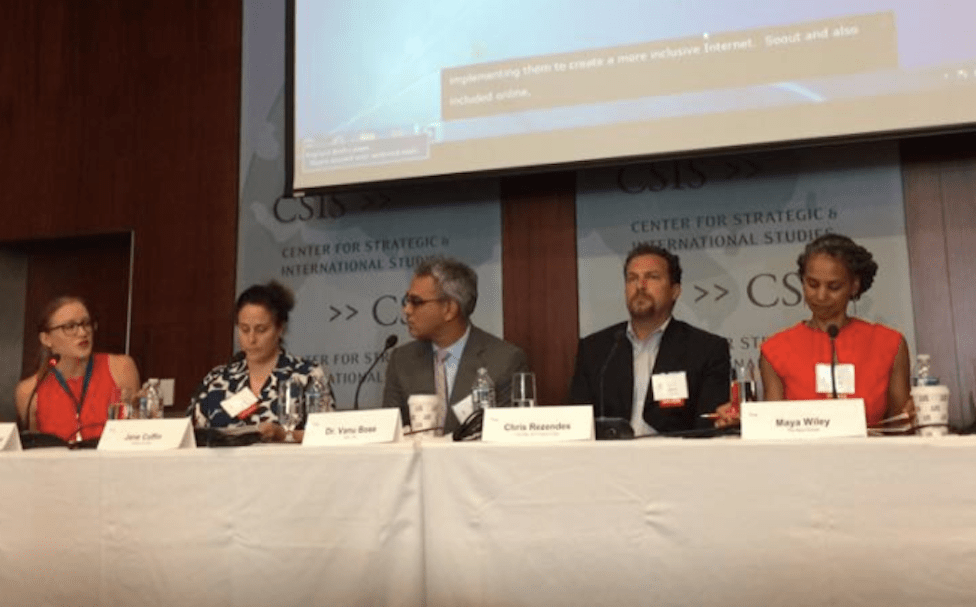The IGF-USA took place in Washington D.C on July 24, 2017. During the event, the panel “Promoting a More Inclusive Internet” looked at current barriers to an inclusive Internet and explored how access could be expanded to underserved areas and to underrepresented communities. Moderated by Dr. Brandie Nonnecke, Research & Development Manager for CITRIS and the Banatao Institute at the University of California-Berkeley and Chair of the San Francisco-Bay Area Internet Society Chapter Working Group on Internet Governance, the panel brought together several experts on access provision, each with many years experience of connecting the unconnected in the USA and overseas.
Decentralized Approach
One of the main themes of the panel was that there is no ‘one size fits all’ approach to getting communities online. Rather than focus on technical deployment, the panelists argued that the focus needs to shift to what Internet access actually means to different communities and to solutions adapted to fit their specific needs. When proposing solutions, the first question that needs to be asked is, ‘What are the problems that Internet access will solve?’ Often, what works for one community won’t work for another. “No one should decide what other people’s Internet access looks like,” noted ISOC’s Jane Coffin. “Going into a community and presenting a solution to people does not work. Communities need to be able to build their own networks and Internet Exchange Points (IXPs) in a way that best suits their needs and gives them the autonomy to maintain and improve them themselves.”
Sustainable and Scalable
Creating trust between network operators and other stakeholders is crucial, as is providing training for local community members to solve network issues and enabling them to pass on this knowledge to others. Ensuring that solutions are scalable is another key factor. In areas where there is no Internet access, getting access to voice and SMS is already a huge improvement. In Rwanda, for example, there is 3G and 4G coverage, but almost all those in rural areas have 2G phones. “One of the reasons for this is battery life,” explained Vanu Bose. “If you have unreliable power, charging up a smart phone is very difficult. It is important to get communities started at whatever level is effective for them and then build on this, layer by layer in the future.”
Access is an Economical Issue
In many underserved or unconnected areas, barriers to access are usually economical rather than technical. The cost of renting space on cell towers is often prohibitive. Low numbers of subscribers in rural areas mean that telcos are unwilling to invest. While setting up a new tower is relatively cheap, the cost of operating a diesel generator to power the tower – and securing it from theft – is often unaffordable, not to mention damaging to the environment. It’s imperative, argued Bose, that these price points are lowered. “In rural Rwanda, cell phone sites were re-engineered to consume much less power, enabling them to run off solar power and eliminating the need for diesel generators,” he explained. “We also switched to a wholesale model, where revenue from the carriers’ subscribers is shared with the infrastructure developer, helping to increase coverage. We also used this model to improve connectivity in rural Virginia.”
Urban and Rural Access are Not Separate Issues
It’s easy to think about the digital divide as a rural problem or something that affects those in developing economies. However, there are 23 million people in the United States without adequate broadband access. While the majority of these are in rural areas or on tribal lands, there are cities across the country where many inhabitants still struggle to access the Internet, usually those in low-income communities or communities who have been excluded, stereotyped, and disinvested in. “To make meaningful change, all stakeholders need to talk about access as a rural-urban issue that is interlinked,” commented Maya Wiley. “Rural access and urban access are still discussed as if they are two competing spheres, both politically and technically, and this needs to change.” Getting unconnected communities involved in Internet governance discussions and mechanisms is also key to the building a more inclusive Internet.
Data, Privacy, and IoT
The panel also discussed how the Internet of Things (IoT) is changing lives. In rural areas around the world, community networks and access improvements have helped IoT take hold in the agricultural sector. Data-driven farming is enabling producers to net higher yields, farm more sustainably and cut costs. And although these are hugely positive factors, rural communities know that these solutions come with a price. “Apps and websites are designed to mine data,” explained Chris Rezendes, “and it is a mistake to think that rural communities and those on tribal lands don’t know this.” There are huge challenges ahead in getting the technology community to rethink almost everything when it comes to IoT. Communities will not just accept whatever access they are offered by whoever happens to be offering a solution. He continued, “Often, the people driving change in these communities are the younger generation and they are often women. They are also digital natives, and they are fully aware of the implications of data privacy and how valuable their data is. They will simply not accept having data about their physical world harvested for profit.”
Watch the recording of “Promoting a More Inclusive Internet Panel.”
Learn about the San Francisco-Bay Area Internet Society Chapter.
Image, from right: Maya Wiley, Senior Vice President for Social Justice and Professor of Urban Policy and Management at the New School, Chris Rezendes, Founder of INEX Advisors and Impact Labs and IoT Capital Partners, Vanu Bose, President and CEO of Vanu Inc., Commissioner to the UN Broadband Commission for Digital Development, Jane Coffin, Director of Development Strategy at the Internet Society, and Dr Brandie Nonnecke, CITRIS and the Banatao Institute at the University of California-Berkeley and Chair of the San Francisco-Bay Area Internet Society Chapter Working Group on Internet Governance. Photo courtesy of Judith Hellerstein.

